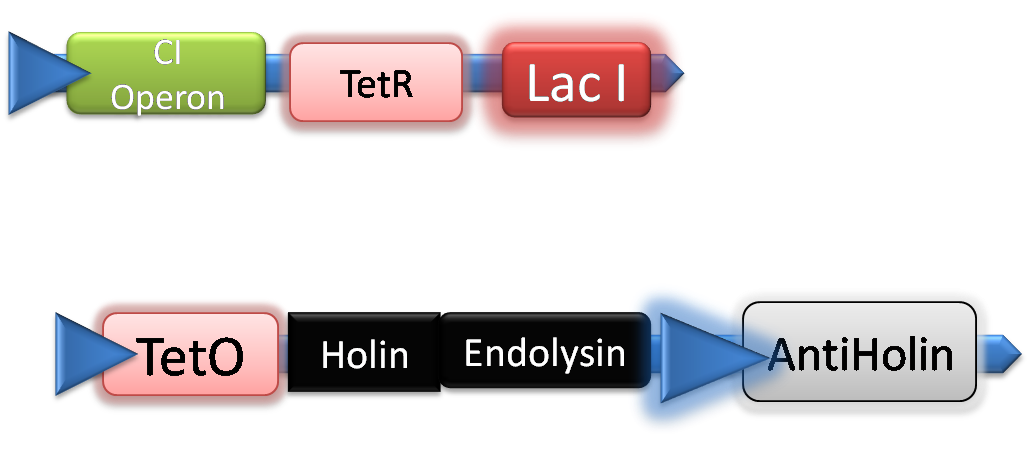Team:Aberdeen Scotland/WetLab/andgate/overview
From 2009.igem.org
University of Aberdeen - Pico Plumber
Introduction:
The AND gate module is at the heart of our project. It was designed so that production of our target protein (in our experiments we used GFP) would only commence in the presence of two imputs, hence being an AND gate (only when imput A AND B are present does 0 become 1). In terms of biology, this module was composed as in Figure 1 below. The imput signals are IPTG which will diffuse into the pipe upon a breach, this will remove the LacI protein inhibiting transcription. The second imput is our luxR activated promoter, this input is triggered upon HSL binding to luxR, this event will occur upon a sufficient quantity of bacteria being in close proximity (see
The LacI latch module was designed to maintain the system in the ON state once it has been triggered, by repressing LacI production, and to induce timed cell lysis by repressing TetR production. These two functions enable production of our target proteins even after IPTG is no longer present, thus producing Elastin for a certain time period after a leak has been closed, allowing for extra strengthening of the weak spot.
The LacI latch module consists of a promoter with a CI operator, a Tet Repressor gene and the LacI gene. The TetOperon and the Lysis Cassete which was developed by the 2008 Berkley iGEM team is then added to the module.
The autolysis mechanism is governed by the activity of bacteriophage encoded holin which induces the formation of hole in the bacterial cytoplasmic inner membrane. The holin pore complex facilitates the insertion of the endolysin, a soluble muralytic enzyme for disrupting the structure of the peptidoglycan in the outer membrane [4]. This tuned activity of holin and endolysin will deliver our glue component at the specific site following the induction of IPTG and quorum sensing. At the cellular level, the function of holin is inhibited by another protein called antiholin. The holin and antiholin are coded from the same coding region of the mRNA and hence generating a difference in only two amino acids [2]. A simple basis for this inhibitory function of antiholin could be the ionic interaction between the negatively charged inner surface of the cytoplasmic membrane and the positively charged lysine in the antiholin structure [1]. The literature [3] suggests that the presence of a thousand holin molecule is required for achieving a lysis timing of 40-45 minutes. This was tested and modelled by the UC Berkeley’08 iGEM team. In our system design, the antihloin is expressed under the control of a weak constitutive promoter so that holin production is able to take over antiholin produced at the time of lysis.
An efficient autolysis and LacI latch mechanism are indispensable for ensuring the desirable time delay (longer than 40 minutes) required for enough glue (tropoelastain and lysyl oxidase ) production and their subsequent mixing . This will be achieved by the slow decay rate in the level of TetR production following the induction by inducer IPTG and the formation of antiholin which is an inhibitor of holin complex formation .
 Back Back
|
Continue 
|
 "
"
